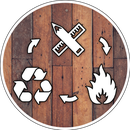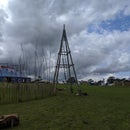Introduction: Electro-etching Aluminium
On the surface this might seem a bit gimmicky, but the subtext to this, I personally think, is fantastic! And that subtext is...
"Here, have a reason to try something you've never done before!"
Exactly the reason I love the maker community and so I dived right in!
Step 1: Prepare Your Stock
I had some 25mm X 5mm aluminium bar lying around but you could use any size of stock you have as long as you can get it thick enough to use for coins.
I got it as flat as possible and then sanded it down. I didn't go crazy with sanding as most of the surface will be removed by etching and the remainder will be polished. I really just removed the dirt from each side.
Step 2: Apply a Mask for Etching
There are a million ways to mask a piece of metal for etching. If you have a laser printer or photocopier, the toner transfer method is really good or you can use a resit-pen or even a sharpie.
I used sticky back vinyl sheeting which I cut with a laser but you could just as easily use a vinyl cutter or an exactoknife.
First I covered each side of the metal with the vinyl. Then i cut the design using the laser.
Finally I removed the vinyl pieces to reveal the negative space.
Step 3: Etching
For etching you will need:
- A glass jar
- A 12v power supply / 12v battery (I believe it can be done with a 9v battery too)
- Some crocodile clips you don't mind getting destroyed
- A bolt/screw
First fill the jar with enough water to cover your piece. then add as much salt as the water will hold, don't worry if you add too much, it'll just sit at the bottom of the jar.
Then connect the negative terminal to the bolt and the positive to your piece and place them in the jar making sure they don't touch.
I left mine in for about an hour but it best to keep checking it as if you leave it in too long it begins to etch underneath the mask and you lose definition in the design.
CAUTION!! - The gasses produced by this process are dangerous and this should only be done in a very well ventilated area!!
Step 4: Finishing
I removed all the remaining vinyl covering and cut the coins out on the band-saw as close as I could to the edge.
Then I finished shaping them on the disc sander.
At this point they are done, however you can polish them in a variety of ways. I recently built a parts tumbler, so I used it...
Step 5: Polishing (Optional)
I made myself a parts tumbler from a coffee can, a motor and some cabinet wheels.
I filled it with plastic "media", which in my case was a whole lot of cut up pieces of 3d printer filament.
I tumbled the coins for a couple of hours and they came out quite nice. If I had the time I would have polished them with a polishing wheel as well to bring up the shine.











